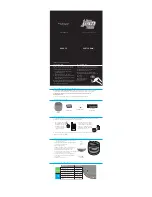
ANALOG/DIGITAL PORTABLE
QUICK
REFERENCE
GUIDE
5100 S
ERIES
P
ORTABLE
R
ADIO
■
APCO Project 25
– Conventional
– Trunked
■
SMARTNET
®
/
SmartZone
®
■
Analog FM
Conventional
VHF
UHF
800 MH
Z
Part No. 002-5100-015
7-04hph Printed in U.S.A.
3. Press the F2 button to select the highlighted parameter. The available
modes for that parameter are then displayed and the currently selected
mode is indicated by an asterisk.
4. Press the Up/Down button to highlight the desired mode. Then press the
F2 key to select that mode.
5. To step back to the previous menu level or exit the menu mode, press
the F1 (Clear) key.
BATTERY REMOVAL / INSTALLATION
To remove the battery from the radio for recharging or replacement, press
the release button (see illustration below) and then rotate the battery
upward to the approximate point shown and
withdrawn it from chassis.
RECHARGING
WARNING: Do not incinerate
a battery pack because it may
explode. Also, do not short circuit the
terminals because the battery pack and the object causing the short may
become very hot. Do not disassemble or modify a battery pack.
If the battery is recharged while attached to the radio, be sure to turn radio
power off. If power is left on, the battery will begin to slowly discharge
when the charger enters the trickle mode (indicated by a green indicator).
This occurs because the charge current in this mode is less than standby
radio current. Power should also be turned off to prevent charger damage
(see Caution which follows).
CAUTION:
Do not transmit in close prox-
imity to the charger because charger damage may result. Note that trans-
missions may occur automatically in the trunked modes.
When the battery fails to hold a charge or provides only a very short oper-
ating time, it must be replaced with a new unit. A fully charged battery
provides approximately 13 hours of service before recharging is required.
This time may be less if more than 5% of the time is spent transmitting or in
the unsquelched receive mode, or if the battery is not fully charged or its
capacity has deteriorated. Dispose of the nickel metal-hydride (NiMH)
battery pack used in this radio in accordance with local waste regulations.
LOW BATTERY INDICATION
When the battery discharges to the point where recharging is required, the
icon is displayed. The battery should be recharged or replaced as soon as
practical after this indication appears. Additional low battery indications
that may be programmed include a beep that sounds every minute, another
that sounds when the PTT switch is pressed, and/or a top panel indicator
that flashes red every 30 seconds.
OPTION BUTTONS
Almost all the buttons on this transceiver are programmable unless they are
dedicated to a specific function. The programmable buttons are as follows:
• On the side panel, the three buttons above the PTT switch.
• On the top panel, the orange button and rotary three-position switch.
• On the front panel, F1 and F2 if the menu mode is not used (see next
section), and F3 and F4.
• With DTMF keypad models, all 12 DTMF keys (0-9, #,
*
).
Each option button can be programmed to control a different function in
each of the three operating modes (conventional, SMARTNET
®
/
SmartZone
®
, Project 25 Trunked).
MENU MODE
Many transceiver functions are controlled by the menu mode, an option
switch, or both. Only the functions which apply to the selected channel
type are displayed. The availability of the menu mode and the parameters
that are selectable are determined by system operator programming. The
menu mode operates as follows:
1. Press the F2 key to
select the menu mode.
The selectable menu
parameters are then
displayed below “MAIN
MENU” as shown.
2.Press the Up/Down
button to scroll up or
down through the list
until the parameter you
want to change is high-
lighted by the bar.
Menu
Exit
Back/
Menu
Select/
Enter
Menu
Scroll
Up/Down
(Continued)
6
7
Battery Release
Button




















